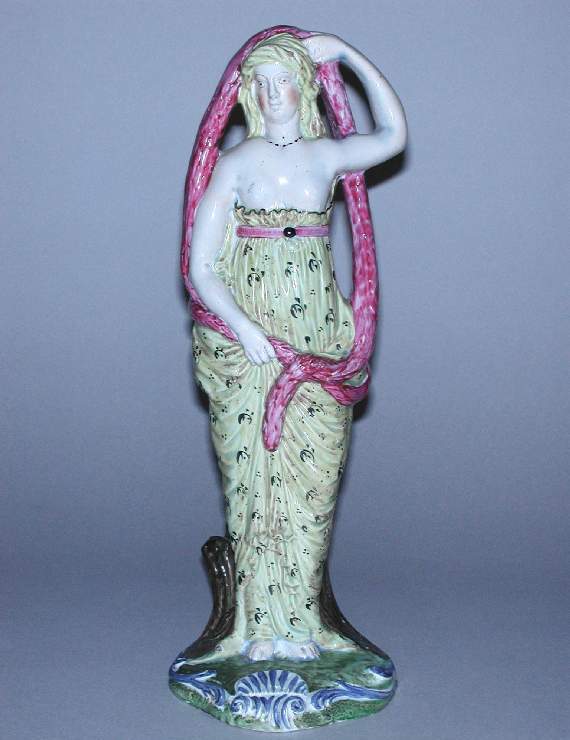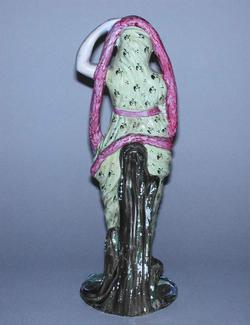Current Location: In storage
Titles
Standing woman
Maker(s)
Production:
Unidentified factory
David Wilson
(Possibly)
Entities
Categories
Description
Earthenware figure, press-moulded, covered with blue-tinted lead-glaze (pearl or china glaze) and painted with polychrome enamels
Earthenware, press-moulded, covered with blue-tinted lead-glaze and painted in blue, green, yellow, pink, and brown enamels. The standing woman wears a long yellow decorated with brown sprigs and a pink belt; the back is drawn up over her head, the front gathered beneath her naked breasts. Her left hand is raised to hold a pink wreath which frames her head and shoulders and is loosely tied around her hips. Her right holds the wreath and grasps the dress in front, revealing her bare toes. Her hair is painted in the same yellow as the dress and she wears a thin string of brown beads. She stands against a stylised tree stump and on an irregular flat green base with blue and white scrolls and a scallop shell to the front. The back is fully detailed and decorated. The underside is open and glazed into the interior.
Notes
History note: Bought from Mr Stewart Acton at Brighton on 29 June 1917, for £3.10s 0d. (three pounds ten shillings), by Dr J.W.L.Glaisher, FRS, Trinity College, Cambridge.
Legal notes
Dr. J.W.L. Glaisher Bequest, 1928
Measurements and weight
Height: 33 cm
Width: 13.5 cm
Acquisition and important dates
Method of acquisition: Bequeathed
(1928-12-07)
by
Glaisher, J. W. L., Dr
Dating
19th Century, first half
George III
Circa
1810
-
Circa
1820
Note
Earthenware figure groups were popular from around 1810, although the earliest examples date from nearly a century earlier. A cheaper alternative to porcelain figures, they were often produced by small potteries; very few are marked. Classical or literary subjects were frequently copied from porcelain examples, but potters increasingly turned to scenes from everyday life and topical events. These early figure groups are often complex, including modelled and moulded parts and applied decoration; the backs, though flat, are decorated. As demand increased, processes were streamlined to allow mass production and by around 1835 the earlier, relatively costly, methods had largely given way to three-part press-moulding.
Rackham (1935) suggests this figure might possibly have been made around 1810 by David Wilson of Hanley. However, the simple two-part moulding and limited palette of bright colours perhaps indicates a later date.
Components of the work
Decoration
composed of
enamels
( blue, green, yellow, pink, and brown)
lead-glaze
( slightly blue tinted)
Materials used in production
white
Earthenware
Techniques used in production
Moulding
: Earthenware, press moulded, covered with blue-tinted lead glaze (pearl or china glaze) and painted with blue, green, yellow, pink, and brown enamels
References and bibliographic entries
Identification numbers
Accession number: C.938-1928
Primary reference Number: 76412
Old object number: 4103
Stable URI
Audit data
Created: Saturday 6 August 2011
Updated: Monday 25 March 2024
Last processed: Tuesday 15 July 2025
Associated departments & institutions
Owner or interested party:
The Fitzwilliam Museum
Associated department:
Applied Arts





